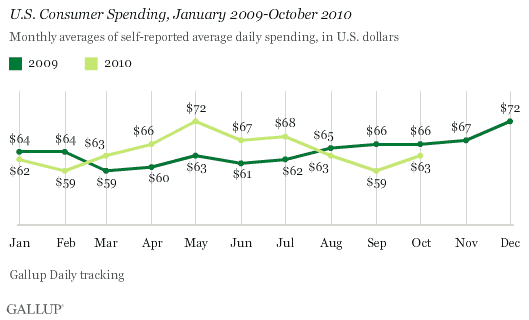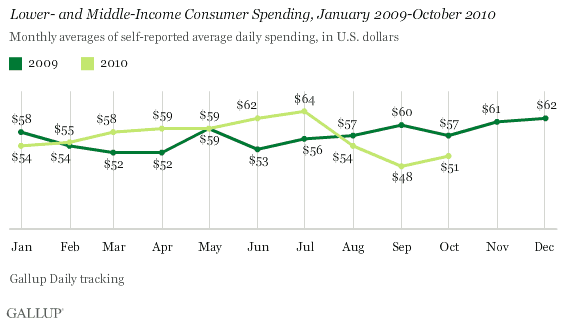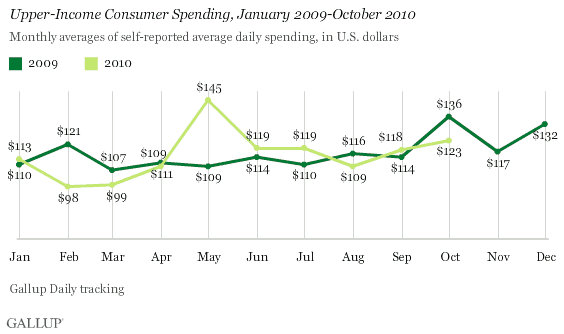PRINCETON, NJ -- Consumers' self-reported daily spending in stores, restaurants, gas stations, and online averaged $63 per day in October -- up slightly from $59 in September, but down slightly from $66 a year ago.

Americans' spending ran slightly higher in March through July 2010 than it did in the same months of 2009, but substantially below the recessionary spending levels of 2008. Since August of this year, though, spending has averaged slightly less than its 2009 comparables.
Lower- and Middle-Income Spending Just Below Low End of "New Normal" Range
Lower- and middle-income Americans' self-reported spending averaged $51 per day during October, up slightly from September's $48, which is the low since Gallup began Daily tracking in January 2008. Consumer discretionary spending by these Americans making less than $90,000 a year remains just below the low end of the 2009-2010 "new normal" monthly spending range of $52 to $64.

Upper-Income Spending Up Slightly in October
Upper-income Americans reported spending an average of $123 per day in October -- up slightly from $118 in September, but down from $136 in October 2009. While spending among this group making $90,000 or more annually was slightly above the 2009-2010 "new normal" monthly range of $107 to $121 per day, this may be a seasonal pattern, with October spending being above the range in 2009 as well.

Commentary
Gallup's self-reported spending measure reflects consumers' discretionary or marginal expenditures, making it highly sensitive to shifting consumer spending patterns. As a result, the new low in lower- and middle-income Americans' spending in September raised the specter of another significant drop in overall U.S. economic activity. And so did a sharp increase in Gallup's unemployment measure during late September and early October.
The slight uptick in consumers' reported spending during October does not do much to change this picture. Spending among lower- and middle-income as well as upper-income Americans trails the weak spending levels of late 2009. Neither Gallup's October Christmas spending intentions measure nor spending during the first week of November -- up slightly but simply matching year-ago levels -- suggests anything other than continued "new normal" spending.
However, Gallup data show a sharp improvement in the jobs situation during late October as well as in economic confidence in early November. Whether this improving picture results from the Federal Reserve's intention to aggressively pour liquidity into the U.S. economy, a surge on Wall Street, the results of the midterm elections, the declining value of the U.S. dollar, or a combination of factors is subject to debate.
Regardless, Gallup modeling suggests that lower- and middle-income spending is sensitive to job market conditions. If job trends continue to improve and confidence along with them, consumer spending could be better than expected late this holiday season.
Gallup.com reports results from these indexes in daily, weekly, and monthly averages and in Gallup.com stories. Complete trend data are always available to view and export in the following charts:
Daily: Employment, Economic Confidence and Job Creation, Consumer Spending
Weekly: Employment, Economic Confidence, Job Creation, Consumer Spending
Read more about Gallup's economic measures.
Results are based on telephone interviews conducted as part of Gallup Daily tracking October 1-31, 2010, with a random sample of 14,799 adults, aged 18 and older, living in all 50 U.S. states and the District of Columbia, selected using random-digit-dial sampling.
For results based on the total sample of national adults, one can say with 95% confidence that the maximum margin of sampling error is ±1 percentage point.
Interviews are conducted with respondents on landline telephones and cellular phones, with interviews conducted in Spanish for respondents who are primarily Spanish-speaking. Each daily sample includes a minimum quota of 150 cell phone respondents and 850 landline respondents, with additional minimum quotas among landline respondents for gender within region. Landline respondents are chosen at random within each household on the basis of which member had the most recent birthday.
Samples are weighted by gender, age, race, Hispanic ethnicity, education, region, adults in the household, cell phone-only status, cell phone-mostly status, and phone lines. Demographic weighting targets are based on the March 2009 Current Population Survey figures for the aged 18 and older non-institutionalized population living in U.S. telephone households. All reported margins of sampling error include the computed design effects for weighting and sample design.
In addition to sampling error, question wording and practical difficulties in conducting surveys can introduce error or bias into the findings of public opinion polls.
For more details on Gallup's polling methodology, visit www.gallup.com.
